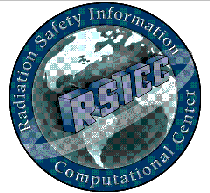CHANGES TO THE COMPUTER CODE COLLECTION
Four changes or additions were made to the computer code collection during the month. One existing code system was
replaced with a newly frozen version, one code system was extended with an additional hardware version, and two code
systems were enhanced with software updates.
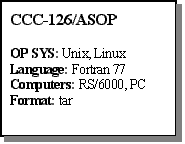 Oak Ridge National Laboratory, Oak Ridge, Tennessee, contributed additional files to allow the IBM
RS/6000 version of ASOP to run on personal computers under the Linux operating system. ASOP is a
shield optimization calculational system based on the one-dimensional discrete ordinates transport
code system ANISN (CCC-254). It has been used to design optimum shields for space applications of
SNAP zirconium-hydride-uranium-fueled reactors and uranium-oxide fueled thermionic reactors and
to design beam stops for the ORELA facility at ORNL. A Fortran 77 compiler is required to compile
and run the code on either IBM RS/6000 under AIX or on personal computers running Linux. The PC
version was tested with Red Hat Linux using the g77 compiler. The package is transmitted on one DS/HD Unix-formatted
diskette in a GNU compressed tar file which includes Fortran source, test case input and output, and makefiles for running
under both AIX and Linux. Reference: CTC-INF-941 (September 1969). IBM RS/6000 or Linux PC; Fortran 77
(C00126/IRISC/00).
Oak Ridge National Laboratory, Oak Ridge, Tennessee, contributed additional files to allow the IBM
RS/6000 version of ASOP to run on personal computers under the Linux operating system. ASOP is a
shield optimization calculational system based on the one-dimensional discrete ordinates transport
code system ANISN (CCC-254). It has been used to design optimum shields for space applications of
SNAP zirconium-hydride-uranium-fueled reactors and uranium-oxide fueled thermionic reactors and
to design beam stops for the ORELA facility at ORNL. A Fortran 77 compiler is required to compile
and run the code on either IBM RS/6000 under AIX or on personal computers running Linux. The PC
version was tested with Red Hat Linux using the g77 compiler. The package is transmitted on one DS/HD Unix-formatted
diskette in a GNU compressed tar file which includes Fortran source, test case input and output, and makefiles for running
under both AIX and Linux. Reference: CTC-INF-941 (September 1969). IBM RS/6000 or Linux PC; Fortran 77
(C00126/IRISC/00).
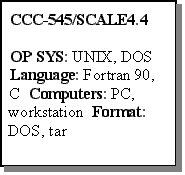 ORNL contributed a newly frozen version of the Standardized Computer Analyses for Licensing
Evaluation modular code system. Many enhancements and corrections were made to SCALE in the
three years since the release of SCALE-4.3. SCALE-4.4 is compatible with the year 2000. The SCALE
system was developed for the Nuclear Regulatory Commission to satisfy a need for a standardized
method of analysis for the evaluation of nuclear fuel facility and package designs. In its present form,
the system can perform criticality, shielding, and heat transfer analyses using well-established
functional modules tailored to the SCALE system. Spent fuel characteristics for these analyses can be
obtained from a module that performs a depletion/decay calculation. User-specified surface detectors
were added to SAS4/MORSE to improve its computational flexibility and efficiency. The KENO-VI input requirements for
HOLEs were simplified and made more consistent with KENO V.a. Additionally, the speed and stability of KENO-VI was
significantly improved. A large number of changes were made to the SAS2H depletion module. A significant effort was made
to minimize the programming differences between the PC and Unix workstation versions. Both versions contain the same
modules. The heat transfer modules HTAS1, HEATING, and the HEATING auxiliary codes are now available in the PC
version for the first time. More details are available in the "Notes to Recipients" which is available in the SCALE4.4
document in PDF format under Electronic Documents on RSICC's www site: http://www-rsicc.ornl.gov/DOCALPH.html.
ORNL contributed a newly frozen version of the Standardized Computer Analyses for Licensing
Evaluation modular code system. Many enhancements and corrections were made to SCALE in the
three years since the release of SCALE-4.3. SCALE-4.4 is compatible with the year 2000. The SCALE
system was developed for the Nuclear Regulatory Commission to satisfy a need for a standardized
method of analysis for the evaluation of nuclear fuel facility and package designs. In its present form,
the system can perform criticality, shielding, and heat transfer analyses using well-established
functional modules tailored to the SCALE system. Spent fuel characteristics for these analyses can be
obtained from a module that performs a depletion/decay calculation. User-specified surface detectors
were added to SAS4/MORSE to improve its computational flexibility and efficiency. The KENO-VI input requirements for
HOLEs were simplified and made more consistent with KENO V.a. Additionally, the speed and stability of KENO-VI was
significantly improved. A large number of changes were made to the SAS2H depletion module. A significant effort was made
to minimize the programming differences between the PC and Unix workstation versions. Both versions contain the same
modules. The heat transfer modules HTAS1, HEATING, and the HEATING auxiliary codes are now available in the PC
version for the first time. More details are available in the "Notes to Recipients" which is available in the SCALE4.4
document in PDF format under Electronic Documents on RSICC's www site: http://www-rsicc.ornl.gov/DOCALPH.html.
The PC version recognizes MS-DOS, Windows 95, Windows 98, and Windows NT operating systems. Executables included
in the PC package were created using the Lahey F90 Fortran compiler version 4.00e in a DOS window of Windows NT 4.0.
Makefiles, source files, batch files, data libraries, and test cases are included in the PC package which is transmitted in DOS
self-extracting compressed files.
The Unix version of SCALE-4.4 runs on IBM RS/6000, DEC, SUN, and HP workstations and requires a minimum of 550
MB to create executables and run test cases. Fortran 90, Fortran 77 and C compilers are required to install the Unix version,
which is transmitted in a GNU compressed tar file that includes source codes, BCD and binary data libraries, makefiles,
scripts, and sample problem input and output. Makefile flags are included to allow the source codes to compile on DEC Alpha
OSF/1, SUN/Solaris, SUN/Sun OS4, HP/HP-UX9, HP/HP-UX10, and SGI/IRIX workstations. SCALE4.4 was tested on the
following Unix systems:
IBM RS/6000 AIX 4.2.1 using XLF90 3.2.5.4
SUN under SunOS 5.6 using f77 4.2, Fortran 90 1.2 and c 4.2
DEC/Alpha 4.0B using Fortran 90 V4.1 compiler
HPUX 10.20 using Fortran 90 and Fortran 77 compilers.
Both Unix and PC versions are included on one CD. NUREG/CR-0200 is included on the CD-ROM in electronic (PDF)
form;it is not distributed in hardcopy form. References: README (September 1998), NUREG/CR-6182, Vol. 1
(ORNL/TM-12663/V1) (November 1994), NUREG/CR-0200, Rev. 6 (ORNL/ NUREG/CSD-2/R6), Vols. I, II, and III
(September 1998) DRAFT. Fortran 90, C (C00545/MNYCP/00).
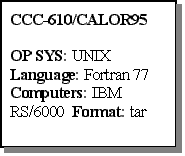 Oak Ridge National Laboratory updated the Sun version of this Monte Carlo code system for the
design and analysis of calorimeter systems, Spallation Neutron Source (SNS) target systems, etc., with
a replacement for the MORSE module. CALOR95 was designed to assist experimentalists in
evaluating and analyzing different types of calorimeter systems used in many high-energy physics
experiments to determine the energy and direction of incident hadrons, leptons, and photons. This code
package contains HETC95, SPECT95, EGS4, MORSE, and other support programs. The MORSE
version in earlier releases of CALOR95 did not yield the correct energy balance because absorbed
gamma-ray energies were underestimated. This correction was made to the IBM RS/6000 version in June 1998. Now the Sun
and IBM RS/6000 versions are functionally equivalent.
Oak Ridge National Laboratory updated the Sun version of this Monte Carlo code system for the
design and analysis of calorimeter systems, Spallation Neutron Source (SNS) target systems, etc., with
a replacement for the MORSE module. CALOR95 was designed to assist experimentalists in
evaluating and analyzing different types of calorimeter systems used in many high-energy physics
experiments to determine the energy and direction of incident hadrons, leptons, and photons. This code
package contains HETC95, SPECT95, EGS4, MORSE, and other support programs. The MORSE
version in earlier releases of CALOR95 did not yield the correct energy balance because absorbed
gamma-ray energies were underestimated. This correction was made to the IBM RS/6000 version in June 1998. Now the Sun
and IBM RS/6000 versions are functionally equivalent.
CALOR95 runs on IBM RS/6000 computers with the XLF Fortran 77 compiler or on Sun Sparc workstations under Solaris
2.6 with the Fortran 4.2 compiler. It is transmitted on one CD-ROM in compressed Unix tar format. References
ORNL/TM-11185 (unpublished report) and SDC-92-00257 (May 1992). Fortran 77; IBM RS/6000 (C00610/IRISC/02); SUN
(C00610/SUN05/02).
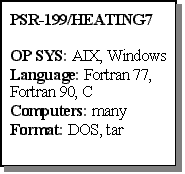 Oak Ridge National Laboratory, Oak Ridge, Tennessee, contributed a minor correction to this
multidimensional, finite-difference heat conduction analysis code system. HEATING can solve
steady-state and/or transient heat conduction problems in one-, two-, or three-dimensional Cartesian,
cylindrical, or spherical coordinates. Both HEATING 7.2i and HEATING7.3 are distributed in this package. The correction
was made to the HEATING 7.3 Windows95/NT user interface to correct problems with restart cases. In the previous version a
restart case would run, but the .prt and .pst files were not saved back to the directory containing the input file.
Oak Ridge National Laboratory, Oak Ridge, Tennessee, contributed a minor correction to this
multidimensional, finite-difference heat conduction analysis code system. HEATING can solve
steady-state and/or transient heat conduction problems in one-, two-, or three-dimensional Cartesian,
cylindrical, or spherical coordinates. Both HEATING 7.2i and HEATING7.3 are distributed in this package. The correction
was made to the HEATING 7.3 Windows95/NT user interface to correct problems with restart cases. In the previous version a
restart case would run, but the .prt and .pst files were not saved back to the directory containing the input file.
HEATING7.2i runs on several Unix systems including IBM RS/6000, Sun, DEC, DEC Alpha, HP and Cray. Fortran 77 and C
compilers are required. For the PC version, a Fortran compiler and DOS extender software are needed to create new
executables or to compile and load user-supplied subroutines. The Microway NDP Fortran 386 4.2.1 compiler was used to
create 7.2i executables included in package. HEATING 7.3 is written in Fortran 77 but includes some Fortran 90 features.
HEATING 7.3 PC executables were created using Microsoft Powerstation v4.0. Visual Basic 4.0 was used to create the
graphical front end for the program. Windows95 or WindowsNT is required to use the GUI version of HEATING 7.3, though
a non-gui version is included in the package that may be run in a DOS window of Windows95 or WindowsNT. HEATING7.3
for Unix was tested only on IBM RS/6000 and requires the XLF 3.2 compiler.
One CD-ROM, readable on both PC and Unix computers, includes the referenced document, source code, PC executables,
script files, and sample cases. References: ORNL/TM-12262 (February 1993). HEATING 7.2i: Fortran 77 and C; UNIX
Workstation or Mainframe: Fortran 77; 386 or 486 PC; HEATING 7.3: Fortran 90 486PC and IBM RS/6000
(P00199/MNYCP/02).
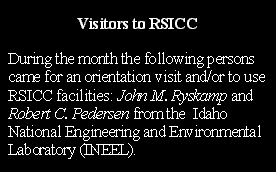
CONFERENCES, COURSES, SYMPOSIA
RSICC attempts to keep its users/contributors advised of conferences, courses, and symposia
in the field of radiation protection, transport, and shielding through this section of the
newsletter. Should you be involved in the planning/organization of such events, feel free to
send your announcements and calls for papers via email to raf@ornl.gov.
The First Latin American Symposium on Nuclear Tracks
The First Latin American Symposium on Nuclear Tracks will be held April 5-9, 1999, in Caracas, Venezuela. The symposium
will be devoted to review of the present knowledge of nuclear track science and technology and its applications in physics,
health, environmental studies, earth sciences and industry. Participants are encouraged to submit one-page abstracts, even if
they might be seen as preliminary results. The list of suggested topics are:
- Basic Physical Processes Related to Track Formation
- Track Observation and Measurement Methodology
- Environmental Radiation and Radon Studies
- Radiation Dosimetry
- Nuclear Physics
- Geoscience
- Medical Physics and Radiobiology
- Archeology
- Industry
- New Trends in Nuclear Tracks Science and Technology
Abstracts with the complementary registration page can be sent in three ways by the February 15, 1999 deadline:
1. By FAX to one the following numbers:
(+58-2) 906-3155 (Laboratorio de Física Nuclear, USB)
(+58-2) 906-3888 (Laboratorio de Física Nuclear, USB)
(+58-2) 605-2188 (Escuela de Física, Facultad de Ciencias, UCV)
2. By E-mail to one of the following addresses:
rmartin@fisica.ciens.ucv.ve
lsajo@usb.ve
asajo@usb.ve
fgutt@pion.ivic.ve
3. Send the abstract either by FAX or E-mail and then proceed with the electronic registration.
Details may be found on the internet at http://fisica.ciens.ucv.ve/~rmartin/1lasont/1lasont.html.
Tenth International Symposium on Reactor Dosimetry
The Tenth International Symposium on Reactor Dosimetry will be held September 12-17, 1999, in Osaka, Japan. This
Symposium is held about every three years to provide a forum for the interchange of state-of-the-art techniques, databases and
standardization of radiation metrology. The Symposium will be of value to those involved in reactor dosimetry, including
researchers, manufacturers and representatives from industry, utilities and regulatory agencies. The Symposium is jointly
sponsored by the Atomic Energy Society of Japan (AESJ), the American Society for Testing and Materials (ASTM) and the
European Working Group on Reactor Dosimetry (EWGRD). It is organized by ASTM Committee E10 on Nuclear
Technology and Applications and EWGRD.
The Symposium theme is dosimetry for the assessment of irradiated reactor materials and reactor experiments, featuring
radiation metrology techniques, databases and standardization. Inquiries and requests to be added to the mailing list should be
sent to one of the following:
North and South America, East and Southeast Asia:
Dr. David W. Vehar
ASTM Program Secretary
Sandia National Laboratories, MS-1136
P.O. Box 5800, Albuquerque, NM 87185-1136, USA
Phone: 505-845-3414, fax: 505-844-0798
email: dwvehar@sandia.gov
Europe, Africa, Asia (other), and Australia:
Dr. Hamid Ait Abderrahim
EWGRD Programme Secretary
SCK/CEN
Boeretang 200, B-2400 Mol, BELGIUM
Phone: 32-14-332277, fax: 32-14-321529
email: haitabde@sckcen.be

"Half a Century of Radiation Shielding Research and Its Evolution into the Next Era" is the theme for the 9th International
Conference on Radiation Shielding to be held October 17-22, 1999, in Tsukuba, Japan. It is sponsored and organized by the
Japan Atomic Energy Research Institute and co-sponsored by the OECD-Nuclear Energy Agency-Nuclear Science Committee
(NEA-NSC), Atomic Energy Society of Japan (AESJ), and the Radiation Safety Information Computational Center (RSICC).
Participants in the conference explore the scientific, technological and engineering issues associated with radiation shielding
in broad nuclear energy systems, accelerator facilities, space and general environments. Detailed information about the
conference may be obtained from Yujiro Ikeda, Japan Atomic Energy Research Institute, Tokai Research Establishment,
Neutron Science Research Center, Spallation Neutronics Laboratory, Tokai-mura, Naka-gun, Ibaraki-ken 319-11 Japan
(phone 81-29-282-6074, fax 81-29-282-5709, email ikeda@fnshp.tokai. jaeri.go.jp) or from the web page at
http://icrs9.tokai.jaeri.go.jp.

Calendar
Your attention is directed to the following events of interest.
October 1998
5th International Conference on Recycling, Conditioning, and Disposal (RECOD '98), Oct. 25-28, 1998, Nice, France, sponsored by the French Nuclear
Energy Society and the European Nuclear Society. Contact: SFEN-RECOD '98, 69-73, rue Dutot, 75015 Paris, France (phone 33-01-4419-6220, email
sfen@wanadoo.fr).
International Nuclear Congress (ENC '98) and World Congress, Oct. 25-28, 1998, Nice, France, sponsored by the European Nuclear Society and others.
Contact: ENC '98 Secretariat, European Nuclear Society, Belpstrasse 23, P.O. Box 5032, CH-3001 Berne, Switzerland (phone 41-31-320-6111, fax
41-31-382-4466, url http://www.acv.ch/enc98).
26th Water Reactor Safety Information Meeting, Oct. 26-28, 1998, Bethesda, Maryland, sponsored by the U.S. Nuclear Regulatory Commission. Contact:
Susan Montelcome (phone 516-344-7235, fax 516-344-3957, email smontele@bnl.gov).
November 1998
Radiation Safety Officer, Nov. 2-6, 1998, Las Vegas, Nevada, a Technical Short Course offering of Nevada Technical Associates. Contact: Nevada
Technical Associates, Inc., P.O. Box 90748, Henderson, NV 89009 (phone 702-564-2798, fax 702-558-7672).
15th International Conference on the Application of Accelerators in Research and Industry, Nov. 4-7, 1998, Denton, Texas, sponsored by the University of
North Texas. Contact: Barbie Stippec (phone 940-565-3252, fax 940-565-2227, email stippec@unt.edu, url http://www.phy.unt.edu/accercon/).
SWR-1000: A Reactor Concept for the Future, Nov. 5, 1998, Königswinter, Germany, sponsored by Informum GmbH. Contact: Inforum Conference Office,
Heussallii10, D 53113 Bonn, Germany (phone 49-0-228-507-223, fax 49-0-228-507-262, email inforum_gmbh@compuserve.com).
International Symposium on Storage of Spent Fuel from Power Reactors, Nov. 9-13, 1998, Vienna, sponsored by the IAEA and OECD Nuclear Energy
Agency. Contact: IAEA, Wagramerstrasse 5, P.O. Box 100, A-1400 Vienna, Austria (phone 43-1-20600, fax 43-1-20607, email official.mail@iaea.org).
19th Low-Level Radioactive Waste Management Conference, Nov. 10-12, 1998, Salt Lake City, Utah, sponsored by the U.S. Department of Energy and the
University of Utah. Contact: Donna Lake (phone 208-526-0234, fax 208-526-9165, email lrd@inel.gov).
TapRoot® Incident/Accident Investigation System User's Conference, Nov. 11-13, 1998, Dallas, Texas, sponsored by System Improvements, Inc. Contact:
Katrina Kidd, System Improvements, Inc., Suite 301, 238 South Peters Rd., Knoxville, TN 37923-5224 (phone 423-539-2139, fax 423-539-4335, email
taproot@taproot.com, url http://www.taproot.com).
ANS Winter Meeting, Nov. 15-19, 1998, Washington, D.C. Contact: James O'Hanlon, Sr. Vice President-Nuclear, Virginia Power, 5000 Dominion Blvd.,
Glen Allen, VA 23060 (phone 804-273-3551, fax 804-273-3759).
Meeting of the Americas: Nuclear Science, Technology, and Applications, Nov. 15-19, 1998, Washington, D. C. sponsored by the ANS, the Canadian
Nuclear Society, ANS Latin American Section, the Brazilian Nuclear Energy Association, the Nuclear Technology Association of Argentina, and Soc.
Nuclear Mexicana. Contact: Donald Hoffman (phone 301-984-4400, fax 301-984-7600).
International Symposium on Evolutionary Water-Cooled Reactors, Nov. 30-Dec. 4, 1998, Seoul, Republic of Korea, sponsored by the IAEA. Contact: IAEA,
Wagramerstrasse 5, P.O. Box 100, A-1400 Vienna, Austria (phone 43-1-20600, fax x43-1-20607, email official.mail@iaea.org).
December 1998
Nuclear Decom '98, Dec. 2-3, 1998, London, sponsored by the Inst. of Mechanical Engineers. Contact: Alison Hamlett (phone 44-0171-304-6864, fax
44-0171-222-9881, email a_hamlett@imeche.org.uk).
April 1999
First Latin American Symposium on Nuclear Tracks and Radiation, April 5-9, 1999, Caracas, Venezuela, Institute for Advanced Studies, Convention Centre.
Contact: Professor Laszlo Sajo, Universidad Simon Bolivar, FE-1, Apdo 89000, Caracas, Venezuela, (phone 58-2-906- 3590, fax 58-2-906-3712, email
lsajo@fis.usb.ve).
June 1999
Conference on Radionuclide Metrology and its Application, June 7-11, 1999, Prague. Contact: Pavel Dryák, Czech Metrological Institute, Radiova 1, CZ 102
00 Prague, Czech Republic (phone 420-2-67008244, fax 420-2-67008466, email pdryak@cmi.cz).
September 1999
Tenth International Symposium on Reactor Dosimetry, Sept. 12-17, 1999, in Osaka, Japan. Contact: Dr. David W. Vehar (505-845-3414, fax 505-844-0798,
email: dwvehar@sandia.gov) or Dr. Hamid Ait Abderrahim (32-14-332277, fax 32- 14-321529, email haitabde@sckcen.be).
October 1999
Half a Century of Radiation Shielding Research and Its Evolution into the Next Era (ICRS-9), Oct. 17-22, 1999, Tsukuba, Japan, sponsored and organized by
the Japan Atomic Energy Research Institute. Contact: Yujiro Ikeda, Japan Atomic Energy Research Institute, Tokai Research Establishment, Neutron
Science Research Center, Spallation Neutronics Laboratory, Tokai-mura, Naka-gun, Ibaraki-ken 319-11 Japan (phone 81-29-282-6074, fax 81-29-282-5709,
email ikeda@fnshp.tokai.jaeri.go.jp, url http://icrs9.tokai.jaeri.go.jp.

AUGUST ACCESSION OF LITERATURE
The following literature cited has been reviewed and placed in the RSICC Information Storage and Retrieval Information System (SARIS), now searchable
on the RSICC web server (http://www-rsicc.ornl.gov/SARIS.html). This early announcement is made as a service to the shielding community. Copies of the
literature are not distributed by RSICC. They may generally be obtained from the author or from a documentation center such as the National Technical
Information Service (NTIS), Department of Commerce, Springfield, Virginia 22161. For literature listed as available from INIS contact INIS Clearinghouse,
International Atomic Energy Agency, P.O. Box 100, A-1400 Vienna.
RADIATION SHIELDING LITERATURE
Health Phys., 75, 77-85 . . . Effects of Intake Function Shape on Internal Dose Estimations. . . . Manuca, D.; Kearfott, K.J. . . . July 1998 . . . University of
Michigan, Ann Arbor, MI.
Health Phys., 75, 197-204 . . . The Characterization of a Commercial Mosfet Dosimeter System for Use in Diagnostic X Ray. . . . Bower, M.W.; Hintenlang,
D.E. . . . August 1998 . . . University of Florida, Gainsville, FL.
Health Phys., 75, 93-196 . . . Radiation Shielding Implications of Computed Tomography Scatter Exposure to the Floor. . . . Langer, S.G.; Gray, J.E. . . .
August 1998 . . . Mayo Clinic and Foundation, Rochester, MN; University of Washington Medical Center, Seattle, WA.
Health Phys., 75, 170-178 . . . Effective Dose Equivalent and Effective Dose for Photon Exposures from Point and Disk Sources on the Floor. . . . Kim,
C.H.; Reece, W.D.; Poston, J.W., Sr. . . . August 1998 . . . Texas A&M University, College Station, TX.
Health Phys., 75, 165-169 . . . Monte Carlo Determination of Gamma-Ray Dose Rate with the Geant System. . . . August 1998 . . . J. Stefan Institute and
University of Ljubljana, Ljubljana, Slovenia.
Health Phys., 75, 130-135 . . . Dose and Cost Considerations for Relocation After Nuclear Accidents. . . . Qu, J.; Ehrhardt, J. . . . August 1998 . . . Tsinghua
University, Beijing, P.R. China; Institut f. Neutronenphysik und Reaktortechnik, Karlsruhe, Germany.
Nucl. Technol., 122, 1-18 . . . Description of Critical Experiments in Spherical Geometry Containing UO2F2 Solution. . . . Pitts, M.; Rahnema, F.;
Williamson, T. G.; Trumble, F. . . . April 1998 . . . Georgia Institute of Technology, Atlanta, GA; Westinghouse Savannah River Company, Aiken, SC.
Nucl. Technol., 122, 43-51 . . . Neutronic and Burnup Characteristics of an Actinide-Reduced Plutonium Fuel with Tungsten. . . . Chang, G.S. . . . April
1998 . . . Idaho National Engineering and Environmental Laboratory, Idaho Falls, ID.
Nucl. Technol., 122, 72-82 . . . Radioactive Contamination Around a Boiling Water Reactor Main Turbine System and Procedures for Minimizing the
Contaminated Area. . . . Otoha, K-I.; Uchida, S. . . . April 1998 . . . Japan Atomic Power Company, Tokyo, Japan; Hitachi, Ltd., Ibaraki, Japan.
Nucl. Technol., 122, 93-103 . . . Simulation of Radionuclide Release from a Repository to the Biosphere: Using a Model-Coupling Concept. . . . Gylling, B.;
Moreno, L.; Neretnieks, I. . . . April 1998 . . . Royal Institute of Technology, Stockholm, Sweden.
Health Phys., 122, 104-124 . . . Evaluation of Kalman Filters and Genetic Algorithms for Delayed-Neutron Nondestructive Assay Data Analyses. . . .
Aumeier, S.E.; Forsmann, J.H. . . . April 1998 . . . Argonne National Laboratory, Idaho Falls, ID.
Nucl. Technol., 123, 184-192 . . . Radionuclide Mass Transfer Rates from a Pinhole in a Waste Container for an Inventory-Limited and Constant
Concentration Source. . . . LeNeveu, D.M. . . . August 1998 . . . Atomic Energy of Canada Limited, Manitoba, Canada.
Nucl. Technol., 123, 320-324 . . . Evaluation of Moderator Assemblies for Use in an Accelerator-Based Neutron Source for Boron Neutron Capture
Therapy. . . . Woollard, J.E.; Blue, T.E.; Gupta, N.; Gahbauer, R.A. . . . September 1998 . . . Ohio State University, Columbus, OH.
Nucl. Technol., 123, 259-267 . . . Comparison Between MCNP and Critical Experiments - A Determination of Bias Values to be Utilized in Licensing
Calculations for High-Level Radioactive Waste Disposal. . . . Wright, K.D.; Tulenko, J.S.; Dugan, E.T. . . . September 1998 . . . University of Florida,
Gainesville, FL.
N-REP-03416.4-0217 . . . Review of Operational Aspects of VARSKIN MOD 2. . . . Davis, S. . . . August 1997 . . . Ontario Hydro Nuclear, Ontario, Canada.
ORNL/M-6576 . . . Introduction to the Theory and Analysis of Resolved (and Unresolved) Neutron Resonances via SAMMY. . . . ; Larson, N.M. . . . July
1998 . . . Oak Ridge National Laboratory, Oak Ridge, TN.
Prot.181/IRP . . . Use of MCNP in Radiation Protection and Dosimetry. . . . 1998 . . . ENEA, Bologna, Italy.
